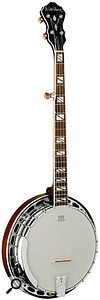I record acoustic instruments fairly regularly, and although I can get a reasonable sound with most, recording the banjo is always a bit of an uphill struggle. I've tried an AT 4033 and an SM57 in numerous positions, but the sound usually falls into one of three categories: 1) like a sitar; 2) boomy — like sticking a mic in a guitar soundhole; 3) woolly — as though recorded through a mountaineer's sock. I can usually 'fix in the mix' to get a passable result, but obviously something is lacking in the original recording.
I am recording five-string bluegrass and clawhammer style, using a mid-range Aria banjo (with resonator). The instrument isn't the best, but the point is that it sounds OK by ear — certainly better than it does on recordings. Any advice?
Via email
 The banjo can be trickier to record accurately than you might think. Be prepared to give it lots of space and plenty of headroom. Technical Editor Hugh Robjohns replies: The banjo isn't something I've had to record often (thankfully), and when I have it has always been in the context of trad jazz bands. However, there are some general principles that might help...
The banjo can be trickier to record accurately than you might think. Be prepared to give it lots of space and plenty of headroom. Technical Editor Hugh Robjohns replies: The banjo isn't something I've had to record often (thankfully), and when I have it has always been in the context of trad jazz bands. However, there are some general principles that might help...
Firstly, the banjo is one of those instruments in which the sound needs space to develop and form (the violin is another example). Close miking always gives a very unnatural sound character, and although you can compensate to some degree with EQ, it is never quite the same as the sound heard acoustically. So, if possible, I would suggest miking from a distance of at least three feet, and possibly further if your room acoustics enable it.
The banjo sound is really all about transient attack, so you'll need a fast, accurate mic with little coloration. A small-diaphragm capacitor (condenser) mic is probably best, and I find aiming it towards the edge of the instrument, rather than the centre, often helps to give the clarity it needs. Make sure you have plenty of headroom in the preamp and recording — those transients are big and fast, and they don't always show up on the meters!
As with all acoustic instruments, no two banjos are ever the same, and it really does pay to experiment with different mic positions and distances to find the best blend of sonic characteristics. If you are having trouble finding a sound that the player thinks is representative of his instrument, you could also try miking over the player's shoulder. At least that way you'll capture what the player is hearing, and that may be exactly what you need.
I've also been told that a lot of bluegrass-style banjo is recorded in stereo with a crossed pair about three feet back.
News Editor Chris Mayes-Wright adds: I've only ever miked a banjo once, and it was during a 'recorded live' session where about nine musicians were playing together. I close-miked the banjo, using a small-diaphragm condenser, but by far the best sound I got was from the violin mic, a large-diaphragm, dual-capsule condenser in omni mode, which was some seven feet away. The close mic sounded OK when the whole group were playing, and was definitely useable in the mix, but for the solo bits (mostly intros to reels), I just soloed the violin mic! So try an omni mic in a decent room about six or seven feet away.
